Politics
Explained In Maps: The 'Battle Of Imphal' 2022
Venu Gopal Narayanan
Jan 17, 2022, 02:59 PM | Updated 02:59 PM IST
Save & read from anywhere!
Bookmark stories for easy access on any device or the Swarajya app.

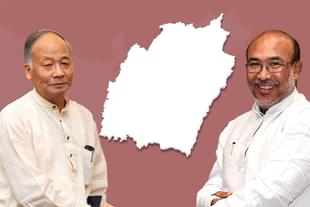
For most Indians, Manipur evokes visions of cultural grace, style and scenic beauty. The state’s classical dance form sends aesthetes into raptures.
The floating gardens of Logtak Lake are a premium destination for travel buffs. And to avid followers of military history, Manipur is holy turf; the Indian Army’s triumph over the Japanese in 1944, at the Battle of Imphal, is one of our greatest victories ever.
But every five years, all of the above is temporarily set aside, when Manipur goes to the polls. Then, punditry and number-crunching takes precedence over a delicate Manipuri mudra, the floating gardens languish from inattention, and the ferocious exploits of the Mahratta Light Infantry regiment (as it was spelt then), at Ukhrul, are resurrected with civil fervour by the Congress and the Bharatiya Janata Party (BJP).
There are 60 seats in the Manipur assembly. Nineteen are reserved for tribals, and one for the Scheduled Castes. Topography and demography split the state into two roughly equal parts.
On the inside is the urbanized Imphal plain, where the Congress retains a strong base. Ringing this region is the hill seats; the Nagas are concentrated in the northeast and northwest, and Kukis and others towards the south and west.
(See here for a detailed study of Manipur’s political dynamics by Jaideep Mazumdar)
In 2022, the battle lines are clearly drawn. The BJP, under Chief Minister N Biren Singh, is finally in formal alliance with the two principal regional parties — the Naga Peoples Front (NPF), and the National People’s Party (colloquially, the NPP; formally, the NPEP).
On the other side is the Congress, largely alone, and still unable to come to terms with the BJP’s spectacular surge from nowhere in 2017.
That paradigm shift forced by the BJP in 2017 came at a substantial cost to others. As a table below shows, the party’s gain of 34.2 per cent, from the mere 2.1 per cent it had in 2012, drew 16 per cent from the Trinamool Congress (TMC, who were decimated), the entire 8 per cent vote share of the now-defunct MSCP, almost all that remained of the Communist vote (5 per cent), a similar takeover of the NCP’s vote base (6 per cent), and 7 per cent from the Congress.
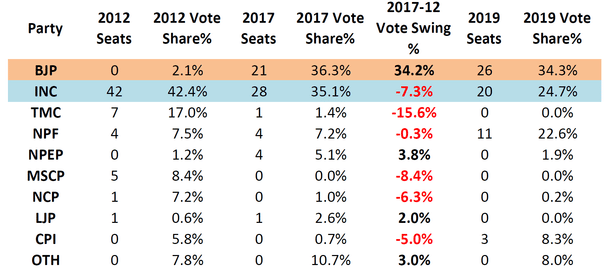
The Congress managed to hold its own in all this, and ended up just a percentage point behind the BJP, and seven seats ahead. The NPF and the NPEP, too, managed to do the same, and subsequently allied with the BJP to form the government.
In 2019, the Congress’ vote share went down further by a full 10 per cent — mainly to the Nagas’ NPF, who successfully contested the tribal-dominated Outer Manipur Lok Sabha seat (the BJP won Inner Manipur).
But, this was a general election, not a provincial one, so it would be presumptuous to assume any sort of repeat in 2022. This is also why the Communists got a temporary lease of life to register 8 per cent, after being wiped out completely in 2017.
Instead, what exists on the ground at present is a fairly intriguing contest between the Congress on the one hand, and the BJP-NPF-NPEP alliance on the other.
Three maps of the 2012 and 2017 assembly election, and the 2019 general election, show how fortunes have shifted in the past decade (Note: the boundary of Inner Manipur Lok Sabha constituency is marked in black on all maps, to aid readers in differentiating between the plains region in the centre, and the hills surrounding it)
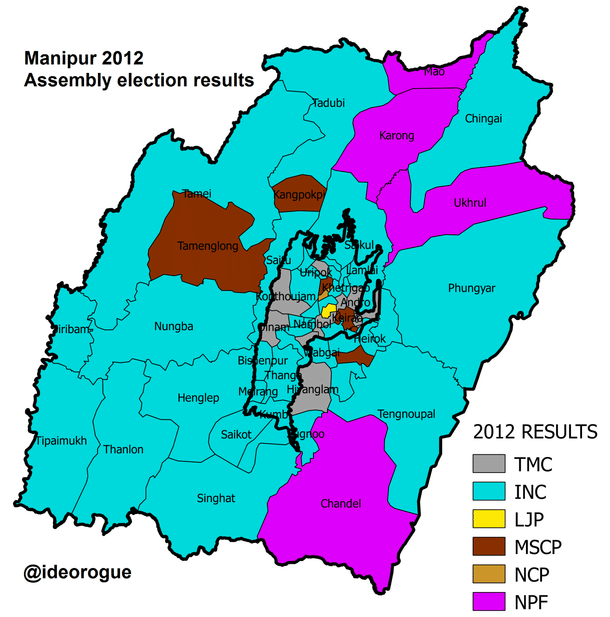
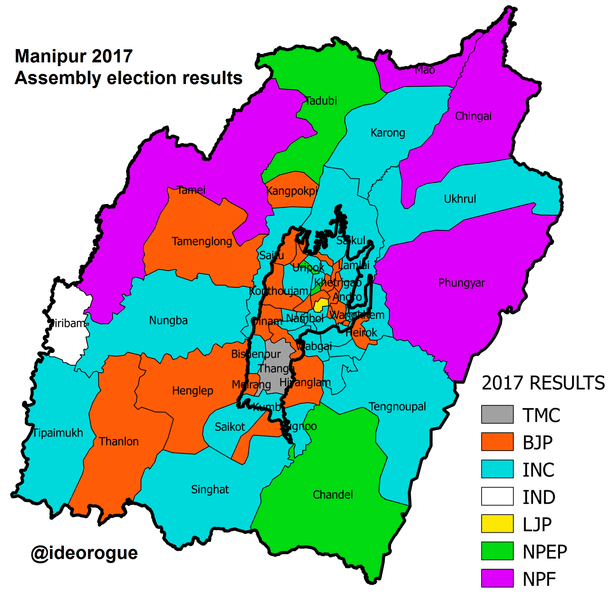
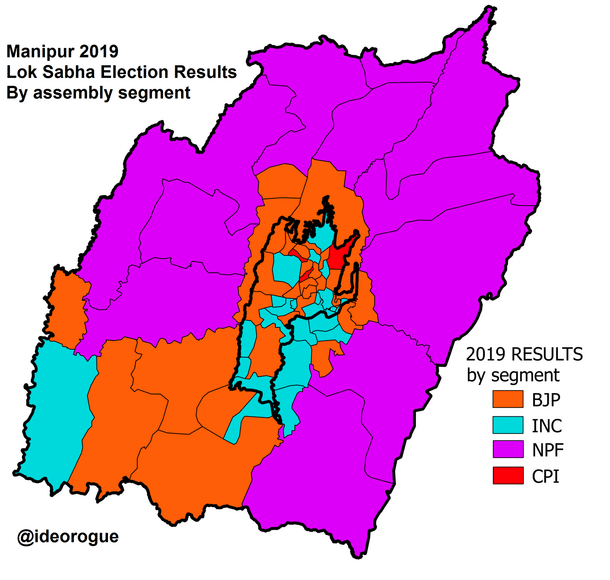
Note how the BJP’s 2017 victory is concentrated in the plains, and how the NPF swept the hills in 2019.
For the Congress, it means that they will have to aggressively target raising their vote share from 2017 levels by at least 8-10 per cent (in effect, go back at least to where they were in 2012), if they are to harbour any serious hopes of regaining the popular mandate.
It’s not impossible, since the contest in Manipur is now the most bipolar it has been in decades. But a map of the Congress’ vote share in 2017 show how tough the task is going to be.
Their position has fallen to below 30 per cent in a number of plains seats (marked grey), and below 20 per cent in some (marked white). And they are not in the running in 10 of the hill seats.
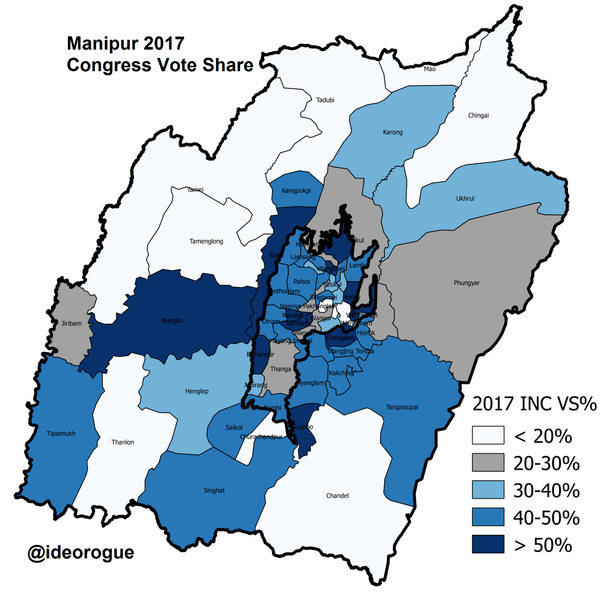
On the other hand, the BJP has chosen to trim its ambitions, and instead, capitalise on its 2017 gains by tying up with the NPF and the NPEP.
A map of the BJP’s vote share in 2017 tells us why:
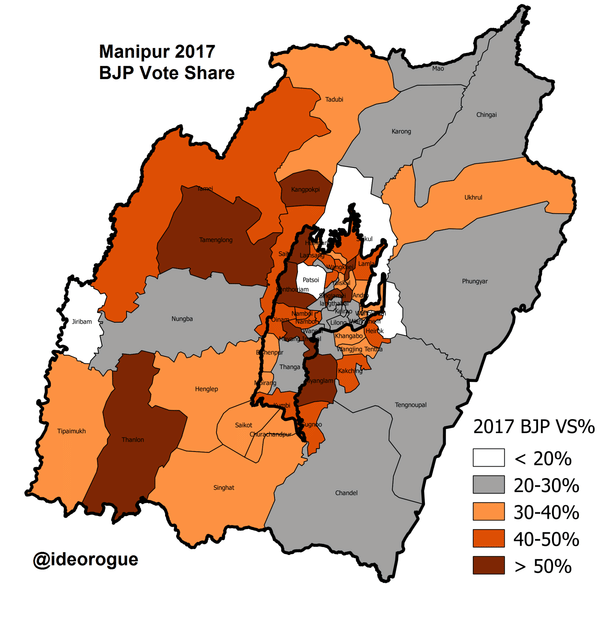
Fourteen of the BJP’s 21 wins in 2017 were from Inner Manipur. Most were solid wins, save Keirao and Noriya, where they scraped through with under 30 per cent on account of a fractured electorate.
Interestingly, though, they did even better in Outer Manipur, which covers 28 seats. The BJP won only seven, but their winning vote shares were higher than in the plains (48.9 per cent versus 44.6). Further, they registered an average vote share of 34.5 per cent in the 19 reserved tribal seats, and won four.
But, there are limitations. An increasingly bipolar contest, plus numerous pockets where other parties and independents can win, means that the BJP may not expect any great increase in its vote share from the 36 per cent it got in 2017. That is why it has tied up with the NPF and NPEP. Both parties bring a solid vote base to the table in a dozen seats each.
The NPF first:
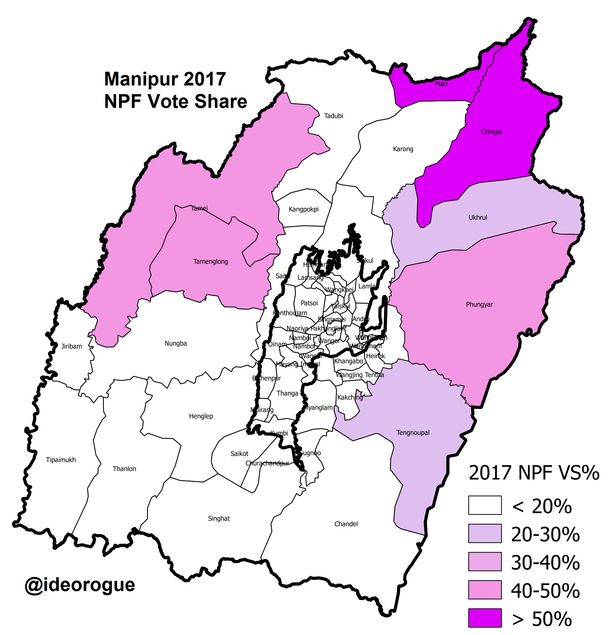
The Naga party won four reserved seats in 2017. It has a good presence in four more (enough to influence the verdict in the BJP’s favour), and a marginal presence in three, which might become important in close contests.
It has a marginal presence in only two general category seats — Jiribam and Kangpokpi (the BJP had its poorest faring of 2017 in the former).
That means the BJP alliance stands a good chance of winning around a dozen seats where the NPF is a factor – of which the Congress won three in 2017, and the BJP none.
The NPEP next:
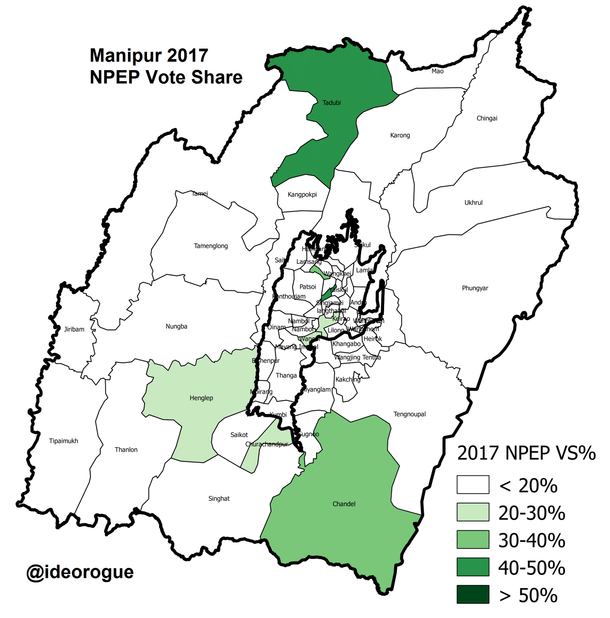
The NPEP won four seats in 2017 — two general, and two tribal. Additionally, it has a good presence in six seats (it came second in two), and a marginal presence in six more. The Congress won eight of these 12 seats in 2017, the BJP, three, and an independent in one (Jiribam).
The NPF is a factor in one (Tengnoupal).
Thus, a BJP-NPEP alliance means that the Congress would be hard pressed to retain even one seat of the eight it won in 2017, out of the total 16 seats where the NPEP is a key factor.
Another variable is the ‘Others’ component which totalled over 16 per cent of the vote share in 2017.
This includes the remnants of the NCP and the TMC, the LJP, and a host of independents.
Combined, they aren’t expected to win more than a handful of seats, but they will influence the outcome in over a dozen seats.
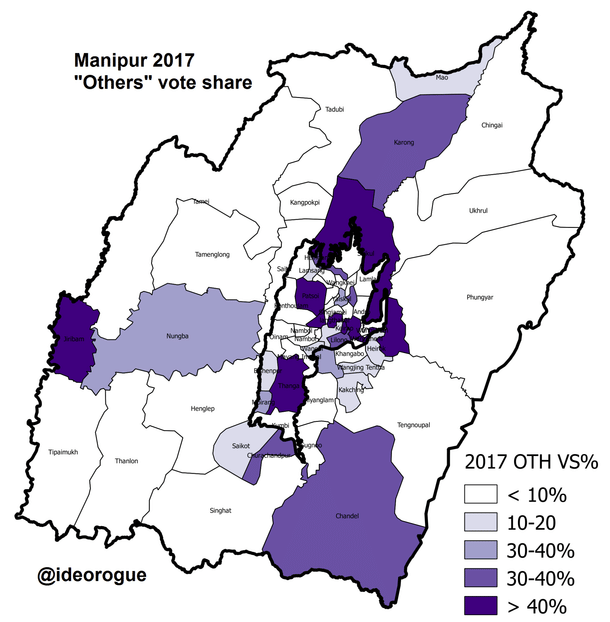
Finally, what does all of the above mean in terms of outcomes? One answer is provided by calculating theoretical margins of victory. For this, the combined 2017 vote share of the BJP, NPF and NPEP in each seat was subtracted by the Congress vote share in that seat.
A negative value means that the Congress is still strong enough to weather the BJP-led alliance in a seat; and a negative value of more than 15 per cent means that it is a sure shot Congress victory (because we can’t fully discard the fact that the Congress did lose 10 per cent of its vote share in 2019).
The results are shown in a map below. Reds favour the Congress, and blues favour the BJP-led alliance.
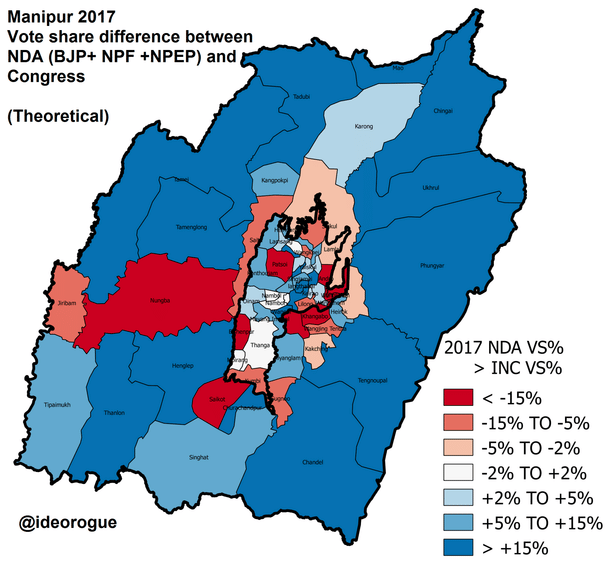
Calculations show that the Congress vote share is greater than the BJP alliance in only 22 seats out of 60.
The Congress won 21 of those in 2017, and an independent, one.
However, the Congress margin is less than 4 per cent in five of those 22 seats, which means that it has a good chance of winning in only 17 seats.
Readers should also note that this set of calculations was done without taking into account any vote swing away from the Congress; so, if that happens, then the party’s fortunes might wither further.
The inference, then, is that vote transfer between the BJP, NPF and NPEP should take place efficiently and profitably, and in spite of numerous disgruntled murmurs doing the rounds in numerous seats.
Thus, in conclusion, the higher probability is that the BJP-led alliance would receive a renewed, enhanced, mandate in Manipur this time.
(All data from Election Commission website)
Venu Gopal Narayanan is an independent upstream petroleum consultant who focuses on energy, geopolitics, current affairs and electoral arithmetic. He tweets at @ideorogue.





